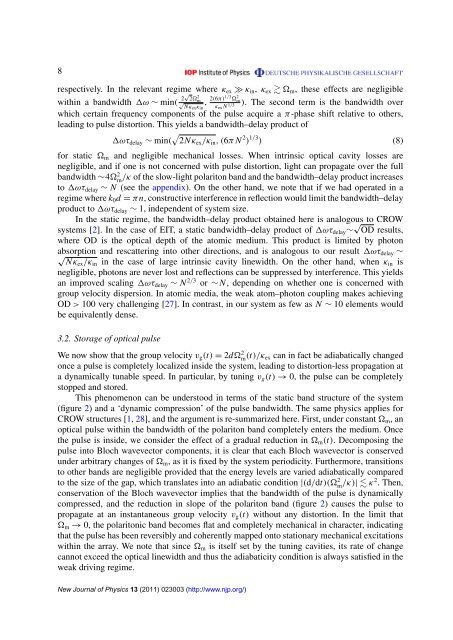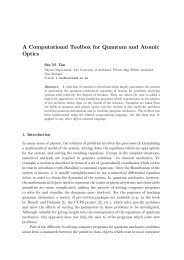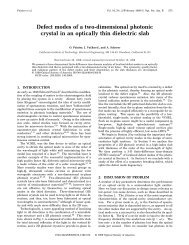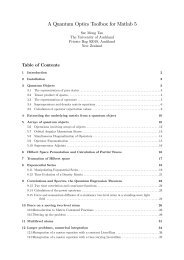Slowing and stopping light using an optomechanical crystal array
Slowing and stopping light using an optomechanical crystal array
Slowing and stopping light using an optomechanical crystal array
You also want an ePaper? Increase the reach of your titles
YUMPU automatically turns print PDFs into web optimized ePapers that Google loves.
8<br />
respectively. In the relev<strong>an</strong>t regime where κ ex ≫ κ in , κ ex m , these effects are negligible<br />
within a b<strong><strong>an</strong>d</strong>width ω ∼ min( 2√ 2<br />
√ 2 m<br />
Nκex κ in<br />
, 2(6π)1/3 2 m<br />
κ ex<br />
). The second term is the b<strong><strong>an</strong>d</strong>width over<br />
N 1/3<br />
which certain frequency components of the pulse acquire a π-phase shift relative to others,<br />
leading to pulse distortion. This yields a b<strong><strong>an</strong>d</strong>width–delay product of<br />
ωτ delay ∼ min( √ 2Nκ ex /κ in , (6π N 2 ) 1/3 ) (8)<br />
for static m <strong><strong>an</strong>d</strong> negligible mech<strong>an</strong>ical losses. When intrinsic optical cavity losses are<br />
negligible, <strong><strong>an</strong>d</strong> if one is not concerned with pulse distortion, <strong>light</strong> c<strong>an</strong> propagate over the full<br />
b<strong><strong>an</strong>d</strong>width ∼4 2 m<br />
/κ of the slow-<strong>light</strong> polariton b<strong><strong>an</strong>d</strong> <strong><strong>an</strong>d</strong> the b<strong><strong>an</strong>d</strong>width–delay product increases<br />
to ωτ delay ∼ N (see the appendix). On the other h<strong><strong>an</strong>d</strong>, we note that if we had operated in a<br />
regime where k 0 d = πn, constructive interference in reflection would limit the b<strong><strong>an</strong>d</strong>width–delay<br />
product to ωτ delay ∼ 1, independent of system size.<br />
In the static regime, the b<strong><strong>an</strong>d</strong>width–delay product obtained here is <strong>an</strong>alogous to CROW<br />
systems [2]. In the case of EIT, a static b<strong><strong>an</strong>d</strong>width–delay product of ωτ delay ∼ √ OD results,<br />
where OD is the optical depth of the atomic medium. This product is limited by photon<br />
absorption<br />
√<br />
<strong><strong>an</strong>d</strong> rescattering into other directions, <strong><strong>an</strong>d</strong> is <strong>an</strong>alogous to our result ωτ delay ∼<br />
Nκex /κ in in the case of large intrinsic cavity linewidth. On the other h<strong><strong>an</strong>d</strong>, when κ in is<br />
negligible, photons are never lost <strong><strong>an</strong>d</strong> reflections c<strong>an</strong> be suppressed by interference. This yields<br />
<strong>an</strong> improved scaling ωτ delay ∼ N 2/3 or ∼N, depending on whether one is concerned with<br />
group velocity dispersion. In atomic media, the weak atom–photon coupling makes achieving<br />
OD > 100 very challenging [27]. In contrast, in our system as few as N ∼ 10 elements would<br />
be equivalently dense.<br />
3.2. Storage of optical pulse<br />
We now show that the group velocity v g (t) = 2d 2 m (t)/κ ex c<strong>an</strong> in fact be adiabatically ch<strong>an</strong>ged<br />
once a pulse is completely localized inside the system, leading to distortion-less propagation at<br />
a dynamically tunable speed. In particular, by tuning v g (t) → 0, the pulse c<strong>an</strong> be completely<br />
stopped <strong><strong>an</strong>d</strong> stored.<br />
This phenomenon c<strong>an</strong> be understood in terms of the static b<strong><strong>an</strong>d</strong> structure of the system<br />
(figure 2) <strong><strong>an</strong>d</strong> a ‘dynamic compression’ of the pulse b<strong><strong>an</strong>d</strong>width. The same physics applies for<br />
CROW structures [1, 28], <strong><strong>an</strong>d</strong> the argument is re-summarized here. First, under const<strong>an</strong>t m , <strong>an</strong><br />
optical pulse within the b<strong><strong>an</strong>d</strong>width of the polariton b<strong><strong>an</strong>d</strong> completely enters the medium. Once<br />
the pulse is inside, we consider the effect of a gradual reduction in m (t). Decomposing the<br />
pulse into Bloch wavevector components, it is clear that each Bloch wavevector is conserved<br />
under arbitrary ch<strong>an</strong>ges of m , as it is fixed by the system periodicity. Furthermore, tr<strong>an</strong>sitions<br />
to other b<strong><strong>an</strong>d</strong>s are negligible provided that the energy levels are varied adiabatically compared<br />
to the size of the gap, which tr<strong>an</strong>slates into <strong>an</strong> adiabatic condition |(d/dt)( 2 m /κ)| κ2 . Then,<br />
conservation of the Bloch wavevector implies that the b<strong><strong>an</strong>d</strong>width of the pulse is dynamically<br />
compressed, <strong><strong>an</strong>d</strong> the reduction in slope of the polariton b<strong><strong>an</strong>d</strong> (figure 2) causes the pulse to<br />
propagate at <strong>an</strong> inst<strong>an</strong>t<strong>an</strong>eous group velocity v g (t) without <strong>an</strong>y distortion. In the limit that<br />
m → 0, the polaritonic b<strong><strong>an</strong>d</strong> becomes flat <strong><strong>an</strong>d</strong> completely mech<strong>an</strong>ical in character, indicating<br />
that the pulse has been reversibly <strong><strong>an</strong>d</strong> coherently mapped onto stationary mech<strong>an</strong>ical excitations<br />
within the <strong>array</strong>. We note that since m is itself set by the tuning cavities, its rate of ch<strong>an</strong>ge<br />
c<strong>an</strong>not exceed the optical linewidth <strong><strong>an</strong>d</strong> thus the adiabaticity condition is always satisfied in the<br />
weak driving regime.<br />
New Journal of Physics 13 (2011) 023003 (http://www.njp.org/)






